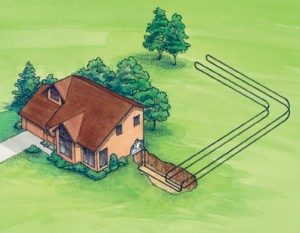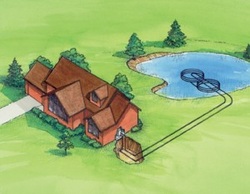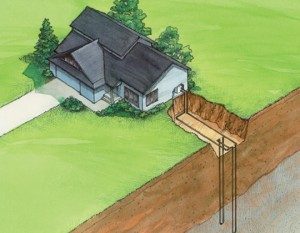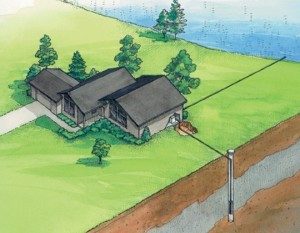
Horizontal Closed Loop Example
Horizontal Closed Loop
Horizontally-excavated or trenched ground heat exchange systems require the most surface area for buried closed-loop GHEX applications, but they are usually the most economical first-cost option compared to vertical or horizontally-bored systems. Due to the extensive excavation normally required, available space is generally the limiting factor. Shallow rock can be challenging also.
The “original” horizontal GHEX consisted of a single pipe loop buried inside a long, narrow trench at some depth underground. Through this pipe water was circulated to and from the heat pump, extracting or rejecting heat geothermally as required during heat pump operation. Adding antifreeze to the water inside this closed loop extended the low operating temperature range of the system below the frost point and protected the heat pump water coil from icing or cracking during winter operation. It also allowed for a shorter loop to be designed, potentially lowering installation costs.
Soon it was found that layering a longer single pipe back-and-forth at varying depths inside an even shorter trench further reduced space requirements and cost without necessarily sacrificing geothermal capacity. By combining multiple pipe loops in parallel on a single consolidated pipe manifold, larger capacity systems could also realistically be achieved.
These evolving approaches were primarily aimed at maximizing system performance at minimal space and installation expense, and they established a practical basis for the way horizontally-excavated GHEX design and installation is approached to this day–with a wide range of variations.
In a climate where frost depths reach 4 to 7 feet, horizontal GHEX piping systems are better laid flat on the bottom of a wider machine-excavated trench, or open pit, dug at least two feet below the deepest annual frost. Open pit excavations are often chosen in soils where caving might occur inside a narrower (e.g., bucket-width) trench, which can severely compromise an application. To help minimize excavation costs and conserve space with limited sacrifice to system performance, horizontal GHEX designs tend to utilize longer pipe lengths–coiled into more dense arrays–inside a smaller excavation footprint than a single straight pipe would normally require.
As a general practice, the number of individual pipe coils used in the GHEX assembly will be the same as the nominal ton capacity of the GHP–that is, a 6 Ton heat pump would utilize 6 coils of equal length in the GHEX. One coil per trench is the rule of thumb. Coils are connected together in parallel on a common supply-return header (manifold). On larger systems, not more than 10 coils usually share the same header before splitting the total number of coils between two–with a few exceptions. The diameter of the HDPE pipe used for coils is usually 3/4″ or 1″ with larger diameters used for headers.
Trenches are commonly dug 6′ to 8′ deep and up to 150′ long (100′ is typical) with a common header trench shared by all. Spools of pipe containing 500 to 800 feet each, determined by design, are used for each trench coil. They are sometimes rolled out back-and-forth along the full length of the trench several times in a linear, evenly spaced “racetrack” fashion…or spread out like a deck of cards from one end of the trench to the other in a radial “slinky” fashion. In either case, both pipe ends of the coil wind up at the same end of the trench for application of the header. Coil spacing and number of runs are determined by design.
In open pit applications, excavation footprint and coil placement tends to be more consolidated than with spaced trenches. Depth remains approximately the same, but open excavations often afford greater versatility in conforming to irregular property shapes and dimensions. Excavation footprint is approximately 400-500 sq. ft. per ton in Michigan, depending on space requirements and soil conditions.
For optimum heat transfer, saturated or even moist soils–found frequently in lower areas–are much preferred over dry. In drier soils, increasing the design loop lengths and/or spacing can often compensate for lower heat transfer rates. So can the introduction of a soaker piping system placed directly above the GHEX coils, where rain or surface water may be periodically diverted. Such considerations are generally given to the specific conditions found at each site.





